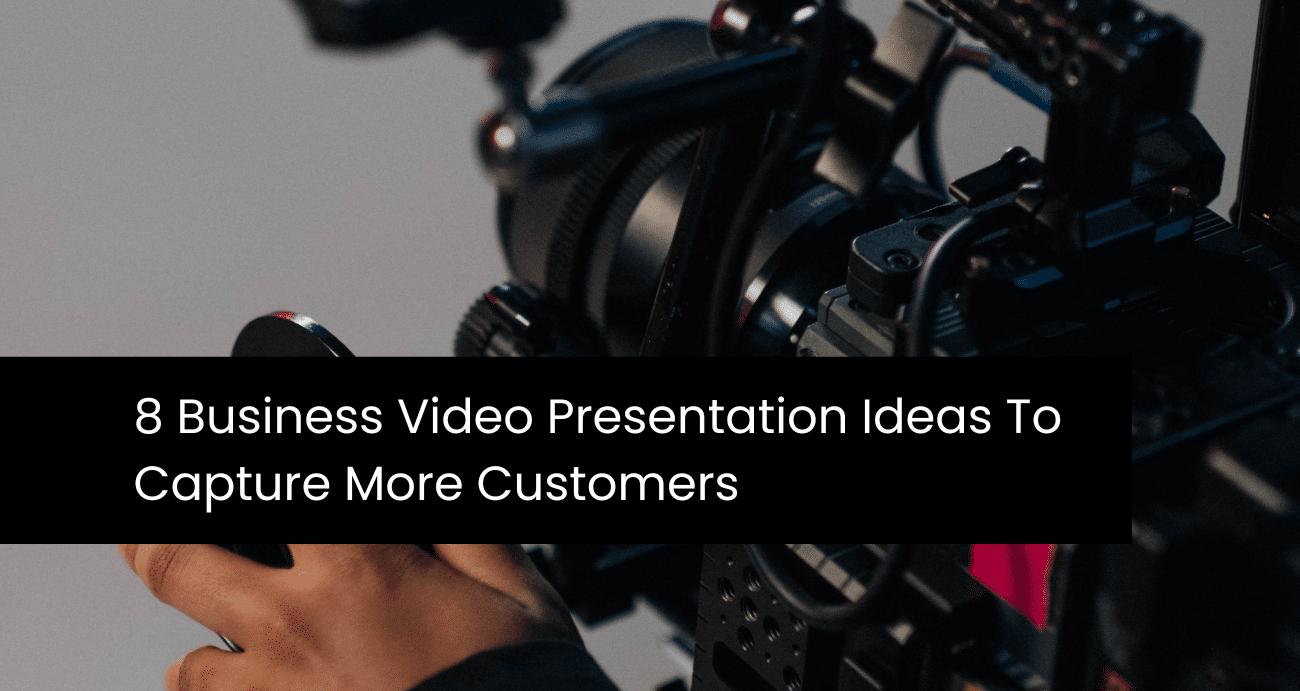Businesses no longer wonder if video marketing is effective. 70% of B2B marketers say that video gives their business a competitive advantage. It’s a great way to show off the benefits of working with your business, or even just what it’s like being an employee there.
Video presentations can be used for any number of things:
- To promote new products or services
- To explain complicated concepts more clearly than text alone could do (for example, how something works)
- To show off the work environment at your company
If you’re thinking about using video in your marketing strategy, here are eight ideas to help you create a winning presentation using video:
1. Behind-the-Scenes Videos
Behind-the-scenes videos are a great way to show your audience what goes into making your product or service. These videos can be used to show your personal brand, how you create products, what materials are used, and how long it takes.
They’re also useful for demonstrating the quality of your products and services by showing them in action, or even better, demonstrating how they work. For example, if you’re selling a new type of vacuum cleaner online then this kind of video would be perfect because it shows potential customers exactly what they’d get if they bought from you instead of another company that doesn’t have behind-the-scenes footage available online (or at least not as many).

2. Personalized Videos
By creating personalized videos, you can easily capture more potential customers. These videos are tailored to your customers and make them feel valued, which can increase engagement and conversions.
Let’s look at an example of a personalized video:
A travel agency wants to promote its new trip packages by sending out an email blast with a link to a video on its website that explains each trip in detail. The company could create one generic video about each package and send it out as part of the email blast, but this won’t be as effective as if they created individualized videos for each customer who receives the email. This way, people will be able to see exactly what they’re getting before booking their trip!

3. Product Demonstration Videos
Customers would always want to know how a certain product works and how it can benefit them. Creating product demonstration videos will help you do this. They can be used in many different ways, including:
- Explaining product features and benefits
- Demonstrating how to use the product
- Showing off the results of using your product (for example, if you sell makeup, show what someone looks like before and after applying makeup).
So, create a video that will show all the details your customers must know about your brand. Don’t worry about large video files because you can easily compress your video files to a smaller file size.
4. Explainer Videos
Explainer videos are a great way to explain complex topics simply and engagingly. For example, if you’re selling a product or service that involves technical terms, such as computer software, then an explainer video would be ideal for explaining the benefits of using it.
If you want to get started with creating an explainer video but don’t know where to begin, here are some tips:
- Write down what message is most important for your audience and make sure that everything else stays secondary until this has been established (this could include the length of time spent on each section).
- Keep things simple by using words that everyone understands rather than industry jargon or technical terms unless necessary (but even then try not to).

5. Tutorial Videos
Tutorial videos are another great way to engage with your customers by helping them understand how your product or service works. These videos can be used in a variety of ways, including:
- Product demonstrations – When you’re selling a new product or service, showing how it works will help potential customers feel confident about their purchase decision.
- Training employees – If you have employees who need training on how to use certain software programs or other tools, creating tutorial videos is an excellent option for providing this information in an engaging way that won’t bore them into boredom!
- Tutorials for clients – If you’re doing work for someone else (like designing websites), then creating step-by-step tutorials on how to use the finished product will save both parties time and energy when setting up future projects together!
6. Customer Testimonials
Customer testimonials are one of the most powerful ways to build trust, establish credibility and increase sales. But if you’re not using them properly, they can be a waste of time. So what are the best strategies for using customer testimonials in your business video presentations?
- Get permission first.
- Use real people and keep it short, sweet, and professional.
- Make sure the customer’s name is visible on the screen so viewers can learn more about them if they want to follow up with them directly for more information or to buy something right away.
- Ask customers how they found out about your company or what made them decide to buy from you in the first place, so you can improve your marketing strategy accordingly to drive more traffic toward your site and increase sales further down the line (after all, every dollar spent on marketing should result in at least two dollars back in sales).
7. FAQ Videos
FAQ stands for “frequently asked questions,” and these videos are designed to answer those questions. FAQs can address any topic, but they’re most commonly used by businesses as a way to address concerns and concerns about their products or services. For example, if you sell custom-made furniture and your clients often ask if they can customize their order, you could make an FAQ video explaining what customization options are available, who is eligible for them (e.g., only new clients), how long it takes to complete the work, etc.

8. Animated Videos
Create an animated video that showcases your product or service. Create gifs, graphics, or animated images for your videos. This can be a fun and engaging way to capture the attention of potential customers and showcase the unique value of your business.
With animated videos, businesses do not have such issues since they do not need any actors or models for their production process. All they need is good writing skills and creativity which will help them create an attractive storyline that audiences will enjoy watching over and over again.
So, how to create video presentations for your business? Here are some tips for you:
Develop a Video Concept
Once you’ve decided to create a video, the next step is to develop a concept. This is where you’ll come up with the idea for your video and determine what it should look like.
A good way to start is by thinking about what kind of content or message you want to convey through your video. Is it going to be an explainer video? A product demonstration? A customer testimonial? Or maybe even just an introduction into who you are and what makes your business different from others in its industry.
Write a Script
- Write a script that outlines the key points you want to cover in your video. It’s important to ensure that it is focused and concise.
- Use bullet points to break down each section of your script into smaller chunks, which will make it easier for you to organize your thoughts and get started on creating the video itself.
Plan Your Video Shoot
If you’re creating a live-action video, plan out the logistics of your shoot. This includes the location and equipment needed as well as talent.
If you have access to professional equipment and crew members, use them! If not, consider hiring an experienced videographer who can help guide you through the process.
Record Your Video
Once you have your script and storyboard ready, it’s time to record your video. If you’re creating a live-action video, film your footage according to your plan. If you’re creating an animated video or a screencast (a type of animation where the characters are created using software), use software such as Adobe Illustrator or After Effects to create the scene in front of the camera.
Edit and Polish Your Video
Once you have your raw footage, it’s time to edit and add finishing touches to your video. This includes transitions, music, voiceovers and captions.
Transitions are used to help the viewer understand how one shot ends and another begins. You can use simple cuts between scenes or more complicated montages that combine multiple shots into one seamless transition like this one:
Music is an important part of any video as it helps set the tone for what’s happening on-screen whether it be upbeat and energetic or more serious and sombre (or even both). Some people prefer using royalty-free music from sites like YouTube Audio Library but if you want something more original then hiring a composer may be worth considering depending on how much money you have available in your budget!
Optimize Your Video for Distribution
Once you have a video, it’s important to optimize it for distribution. This means making sure that your video is ready to be uploaded on the platforms where you want people to see it.
To do this, there are several steps:
- Add tags and descriptions. These can help with search results when someone is looking for content related to what your video covers. For example, if someone searches “how do I make videos,” they may find yours!
- Create thumbnails that look good on mobile devices (you don’t want them too big). You also want them easy enough so that viewers can quickly understand what they’re about without having much time or effort invested into watching them first-hand before deciding whether or not these topics interest them enough for further investigation into other sources of information about those particular topics—such as reading books from authors who specialize in these areas; watching other videos by experts who teach classes about these same subjects; etcetera.
- Consider using video presentation tools that are accessible on the market to improve your video creation process. These tools can assist you in adding professional effects, transitions, and captions, making your videos more engaging and visually appealing.
Publish and Promote Your Video
Once your video is ready to go, publish it on your website and social media channels. Then promote it through email marketing, paid advertising or other channels.
Conclusion
In conclusion, creating powerful video presentations is a great way to capture the attention of potential customers and grow your business. Use these ideas as a starting point to create engaging and effective video content that showcases the value of your brand.




